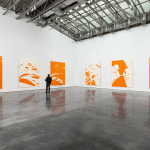
Contributed by Sharon Butler and Jonathan Stevenson / Rebecca Morris, a masterly abstract painter who could do pretty if she wanted to, insists that when a painting starts to look beautiful she catches herself on and pivots to more discomfiting territory. That kind of grim integrity and its visual realization has an austere appeal, but there’s no need right now to get into the niceties of infinite regress or meta paradox. Judging by her solo show at Bortolami, parsimoniously titled “#31” after the number of solo shows she has presented during her career, Morris does consciously resist the pursuit of visual beauty and representation. The large-scale oil-and-spray-paint works are all untitled, distinguished only by parenthetical number indicating the year and the order in which the paintings were made. Each canvas is replete with vivid color and divergent shapes but embodies an irresolute and disconsolate state of play. This could ramify for a given viewer in any number of ways – though not, presumably, as lovely.

Perhaps the piece that epitomizes this quality is Untitled (#14-23). Against an off-white background, scattered swatches of highly differentiated shape, pattern, and color appear to be emerging from or being engulfed by an enveloping force. Morris betrays no specific substantive intent. In fact, she has said that her goal is to make paintings that are purely abstract and resolutely non-referential, and that when she senses that they are moving towards recognizable correspondence with anything objectively identifiable, she takes a different direction. But she cannot completely control viewers’ inferences, and in apprehending this and other Morris paintings it’s hard not to think about issues — such as climate change and its forging of future islands. The thick silver veins in Untitled (#15-22), wending their way among larger expanses of relatively uniform appearance, suggest a detail of the broader phenomenon, Untitled (#04-23) and Untitled (#11-23) maybe higher degrees yet of magnification, while Untitled (#10-23) might scan as its framing as a historical fact.



In several works, Morris explicitly imposes a grid. It evokes Modernism, yes, but also, more vernacularly, maps – latitude and longitude – and distant scrutiny of expanses of, in separate paintings, roiling blue, murky green, and mottled black. Ragged vertical borders suggest real geography. In Untitled (#12-23), an irregular checkered shape occupies a tawny gold field, flanked by three smaller and implicitly fragmentary forms incorporating the same pattern. Some might construe them as facsimiles of American states and conclude that contemporary domestic politics had infiltrated Morris’s work. Though perhaps designed to thwart intellectualization, work this complex and finely wrought can’t help but make you think.

From Morris’ point of view, beauty and importance tend to be at odds. If this is not a timeless observation, it is perhaps a valid one at present. She also places a premium on discordance. Yet these paintings seem to be the most cohesive ones she has ever made, as a group mordantly radiating a sense of dynamic uncertainty and instability. In spite of itself, Morris’ Stella-esque aesthetic rigor, spurning connections with particular objects, themes, or narratives, still seems to osmotically render her work in sync with them. Beautiful.
“Rebecca Morris: #31,” Bortolami, 39 Walker Street, New York, NY. September 8–November 4, 2023.
Also on view:
“Rebecca Morris: 2001–2022,” organized by the Institute of Contemporary Art, Los Angeles (ICA LA) and curated by Jamillah James, Manilow Senior Curator, Museum of Contemporary Art Chicago, and former Senior Curator, ICA LA, with Caroline Ellen Liou, Curatorial Assistant. The presentation at the MCA is organized by James with Jack Schneider, Assistant Curator. / Museum of Contemporary Art Chicago / closes Apr 2024
About the authors:
Sharon Butler is a painter and publisher of Two Coats of Paint.
Jonathan Stevenson is a New York-based policy analyst, writer, and editor, contributing to the New York Times, the New York Review of Books, and Politico, among other publications. He is a regular contributor to Two Coats of Paint.
Related posts:
Rebecca Morris: Loving the unbeautiful
NOTE: The Two Coats of Paint 2023 Year-end Fundraising Campaign is underway, and our goal this year is to reach 100% reader participation. If you enjoy the artist interviews, exhibition reviews, NYC and HV Selected Gallery Guides, and other Two Coats painting-cenric content, this is your opportunity to be a part of it. Please consider making a tax deductible contribution to support the project in 2024. Thank you for all your help keeping the conversation going.























Loved this show!